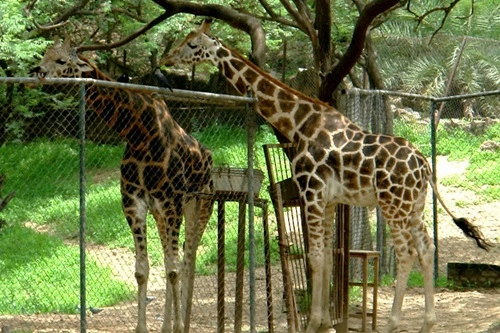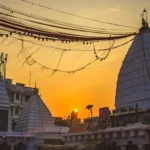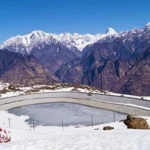The National Zoological Park, commonly known as Delhi Zoo, is one of the largest and most well-maintained zoos in India. Located near the iconic India Gate, this 176-acre zoo is home to over 1,000 animals representing 90 different species, including the majestic white tiger, Indian rhinoceros, African lions, Asiatic elephants, and a vibrant variety of birds. The zoo offers a peaceful escape within Delhi, drawing families, nature lovers, and wildlife enthusiasts who want to experience wildlife up close.
Choosing the best time to visit the Delhi Zoo enhances the experience, allowing visitors to explore the zoo’s expansive grounds comfortably and maximize wildlife sightings. From the cooler, breezy winters to the refreshing monsoon atmosphere, each season in Delhi brings something unique to the zoo. Here’s a guide to help you decide when to visit the Delhi Zoo and what to expect during each season.

Experiencing the Wildlife at Delhi Zoo
Delhi Zoo offers an opportunity to explore diverse ecosystems and habitats in one location. The zoo is divided into several sections, including an aviary, a reptile house, and enclosures for animals like tigers, leopards, elephants, and bears. The zoo’s design aims to mimic natural habitats, with spacious enclosures, water bodies, and dense greenery, providing animals with a comfortable and close-to-natural living environment.
For bird watchers, the zoo’s aviary houses both native and exotic species, such as peacocks, pelicans, and painted storks, making it a haven for avian enthusiasts. Additionally, Delhi Zoo’s location along the banks of the Yamuna River allows visitors to experience beautiful green landscapes and scenic water bodies while exploring the animal exhibits.
Best Seasons to Visit Delhi Zoo
1. Winter (October to March)
Winter is the best season to visit Delhi Zoo, with temperatures ranging from 8°C to 22°C. The cool, comfortable weather makes it easy to explore the zoo’s expansive grounds, allowing visitors to spend hours observing the animals without worrying about heat or humidity.
During winter, animals tend to be more active, especially during the morning and late afternoon hours, increasing the chances of witnessing their natural behaviors. The cooler temperatures mean animals are less likely to seek shade, making it easier to spot the white tigers, lions, and deer roaming around their enclosures. The zoo’s lush, green landscapes and flower gardens are also at their most vibrant in winter, adding to the scenic appeal of a day outdoors.
Winter is an especially good time for families and tourists, as the weather allows for leisurely strolls through the zoo. For bird watchers, the winter season is a highlight, as migratory birds arrive at the zoo’s water bodies, adding diversity to the bird species visible in the aviary.
Early mornings and late afternoons are ideal for spotting active animals and capturing memorable photographs. Since winter is the peak tourist season in Delhi, it’s advisable to visit on weekdays or early in the morning to avoid larger crowds.
2. Summer (April to June)
Summer in Delhi can be quite intense, with temperatures often exceeding 40°C, especially in May and June. While this season is not the most popular time to visit, those who do visit during the early summer months (April and early May) can still enjoy the zoo if they plan their visit for early mornings or late afternoons when the temperatures are cooler.
During summer, many animals tend to be less active in the heat and may retreat to shaded areas, so timing your visit around the cooler hours of the day is essential. The zoo provides shaded paths, benches, and small water fountains throughout, but it’s still advisable to carry water, wear light clothing, and use sun protection to stay comfortable.
While summer may not be ideal for wildlife sightings, it does offer a quieter, less crowded experience. For those who prefer fewer crowds, summer offers a peaceful atmosphere, allowing visitors to explore at a slower pace. Early mornings, when the animals are more active and temperatures are manageable, are the best time for a summer visit.
3. Monsoon (July to September)
The monsoon season brings a refreshing change to Delhi Zoo, as rains transform the landscape into a lush, green environment. Temperatures during the monsoon season range from 25°C to 35°C, and the rain brings relief from the intense summer heat. The zoo looks especially scenic in the monsoon, with the trees and plants in full bloom, providing a beautiful backdrop to the animal enclosures.
Monsoon offers a good balance of pleasant weather and fewer crowds, making it a great time for nature lovers and photographers who appreciate the beauty of rain-washed landscapes. However, the rains can be unpredictable, so it’s advisable to carry an umbrella or raincoat. Some animals may seek shelter during heavy rain, but visitors can still enjoy observing several species, especially in the reptile house and aviary.
Early mornings in monsoon offer the best chance for wildlife sightings, as the animals tend to come out in the cooler, post-rain weather. For bird watchers, the monsoon season attracts more avian species to the zoo’s water bodies and nearby areas, providing unique bird-watching opportunities.
Key Attractions and Activities at Delhi Zoo
- White Tiger Enclosure: The white tigers are among the zoo’s most popular attractions, and their spacious enclosure allows visitors to observe these majestic animals in a naturalistic setting. Early mornings are the best time to see them active.
- Reptile House: The reptile house at Delhi Zoo houses a variety of snakes, crocodiles, and lizards. It’s an excellent spot to visit during hot or rainy weather, as the indoor environment provides a close look at these fascinating creatures.
- Aviary and Bird-Watching: The aviary is home to numerous bird species, both native and exotic. In winter, migratory birds add diversity to the collection, making it an ideal spot for bird enthusiasts and photographers.
- Elephant Enclosure: The elephant enclosure is a must-visit, as these gentle giants are a favorite among families and children. Watching the elephants play in their water pool or interact with each other is a delightful experience.
- Deer Park and Indian Rhinoceros Enclosure: The zoo has a large deer park where visitors can see species like spotted deer and sambar. The Indian rhinoceros, another rare attraction, is housed in a well-designed enclosure that allows for unobstructed views.
- Educational Exhibits: The zoo regularly hosts educational exhibits and informational boards to help visitors understand the importance of wildlife conservation. Children and students can learn more about the animals and their habitats through these interactive displays.
Practical Tips for Visiting Delhi Zoo
- Entry Timings and Tickets: The zoo is open from 9:00 AM to 4:30 PM in winter and from 8:30 AM to 5:30 PM in summer. It remains closed on Fridays. Tickets can be purchased on-site, and online booking options are available to avoid queues.
- Best Time of Day for Wildlife Sightings: Early mornings and late afternoons are ideal for spotting active animals, especially in winter and monsoon. Midday visits are best avoided during summer due to the heat.
- Food and Water: While outside food is not allowed, the zoo has small food kiosks and drinking water facilities. Carry your own water bottle and refill it as needed to stay hydrated.
- Clothing and Gear: Wear comfortable clothing suited to the season. Light, breathable attire is ideal for summer, while a jacket or shawl may be needed for winter mornings. For monsoon visits, carrying an umbrella or raincoat is recommended.
- Photography: Photography is allowed, but avoid using flash, as it can disturb the animals. The zoo’s scenic pathways and enclosures provide excellent opportunities for photography, especially in winter when the weather is clear.
- Respect Wildlife: Visitors are encouraged to respect the animals and their habitats. Avoid making loud noises, do not litter, and follow all rules and guidelines provided by zoo staff.
Conclusion
Delhi Zoo is an ideal destination for anyone looking to explore wildlife and nature without leaving the city. From the cool, bustling winter season to the lush monsoon landscapes and the quieter summer mornings, each season at Delhi Zoo offers a unique experience. Whether you’re visiting to see the majestic white tigers, capture photos of vibrant birds, or simply enjoy a day outdoors with family, planning your visit around the best season and time of day ensures a memorable experience. Embrace the beauty and diversity of wildlife in the heart of Delhi, where animals and nature come together to create an inspiring urban sanctuary.


